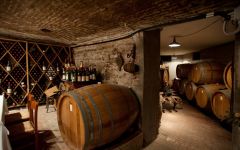Viberti Barolo Buon Padre 2017
-
Wine
Enthusiast -
Robert
Parker



Product Details
Your Rating
Somm Note
Winemaker Notes
Buon Padre is a garnet red color. Aromas of spices, undergrowth, game, dried fruit, and leather. Pairs well with game, red meats, cheeses and cured meats.
Professional Ratings
-
Wine Enthusiast
Leather, grilled herb and dark-skinned fruit aromas lead the way. The smooth, solid palate offers Marasca cherry, star anise and toasted hazelnut alongside firm, polished tannins. Drink 2023–2032.
-
Robert Parker's Wine Advocate
Here's a wine that vaunts its hot-vintage aromas of wild rose, cherry and red fruit in a careful and contained manner. The Giovanni Viberti 2017 Barolo Buon Padre draws its fruit from nine different vineyard sites: Bricco delle Viole, San Pietro, La Volta, Fossati, Alessandria, San Ponzi, Albarella, Ravera and Terlo. The results are balanced, and indeed this wine reveals more acidity or freshness than we see in most of its peers from the challenging 2017 vintage. That freshness gives the wine a greater sense of lively fruit and accessibility. Buon Padre (the "good father") is a solid medium-term Barolo for a fatty lamb dish.
Other Vintages
2018-
Robert
Parker -
James
Suckling
-
James
Suckling -
Wine
Spectator
-
James
Suckling
-
James
Suckling -
Wilfred
Wong -
Wine
Enthusiast
-
Wine
Spectator -
James
Suckling





Viberti, located in the village of Barolo in the northern Italian region of Piedmont, was founded in the early 20th century by Antonio Viberti, an innkeeper and restauranteur. Wine was produced from the estate vineyards exclusively for the patrons of the family restaurant, Trattoria al Buon Padre.
In 1967, ata time when Barolo wines were gaining international notoriety, Antonio's son, Giovanni, joined the family business and realized the potential of the estate vineyards to produce superior quality, world-class Barolo. After selling wines to restaurant patrons, who came from far and wide to enjoy the local cuisine, the reputation of Viberti Barolo spread leading to demand beyond Piedmont.
One hundred years after the creation of the Viberti winery, the family's connection to their beloved land of Barolo and its fine red wines remains unbroken as the 3rd generations of the Viberti family, GianLuca and Claudio, joined their father at the winery. Today, under the direction of Claudio, the winery produces varietally accurate, elegantly structured wines with fresh fruit aromas, bold tannins, and vibrant acidity that are approachable upon release, yet reward extensive aging.

Responsible for some of the most elegant and age-worthy wines in the world, Nebbiolo, named for the ubiquitous autumnal fog (called nebbia in Italian), is the star variety of northern Italy’s Piedmont region. Grown throughout the area, as well as in the neighboring Valle d’Aosta and Valtellina, it reaches its highest potential in the Piedmontese villages of Barolo, Barbaresco and Roero. Outside of Italy, growers are still very much in the experimentation stage but some success has been achieved in parts of California. Somm Secret—If you’re new to Nebbiolo, start with a charming, wallet-friendly, early-drinking Langhe Nebbiolo or Nebbiolo d'Alba.

The center of the production of the world’s most exclusive and age-worthy red wines made from Nebbiolo, the Barolo wine region includes five core townships: La Morra, Monforte d’Alba, Serralunga d’Alba, Castiglione Falletto and the Barolo village itself, as well as a few outlying villages. The landscape of Barolo, characterized by prominent and castle-topped hills, is full of history and romance centered on the Nebbiolo grape. Its wines, with the signature “tar and roses” aromas, have a deceptively light garnet color but full presence on the palate and plenty of tannins and acidity. In a well-made Barolo wine, one can expect to find complexity and good evolution with notes of, for example, strawberry, cherry, plum, leather, truffle, anise, fresh and dried herbs, tobacco and violets.
There are two predominant soil types here, which distinguish Barolo from the lesser surrounding areas. Compact and fertile Tortonian sandy marls define the vineyards farthest west and at higher elevations. Typically the Barolo wines coming from this side, from La Morra and Barolo, can be approachable relatively early on in their evolution and represent the “feminine” side of Barolo, often closer in style to Barbaresco with elegant perfume and fresh fruit.
On the eastern side of the Barolo wine region, Helvetian soils of compressed sandstone and chalks are less fertile, producing wines with intense body, power and structured tannins. This more “masculine” style comes from Monforte d’Alba and Serralunga d’Alba. The township of Castiglione Falletto covers a spine with both soil types.
The best Barolo wines need 10-15 years before they are ready to drink, and can further age for several decades.
